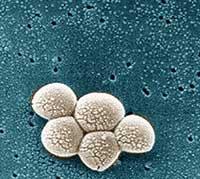Why are they resistant?
The discovery of penicillin and the development of antibiotics led to the hope that at some point any disease would be cured. Years later, bacteria have 'learned' to overcome the effect of antibiotics. Little by little XX. Dependent drugs are losing effectiveness. The dominated diseases are becoming serious in hospitals. It is a big problem.

Staphilococcus aureus is a dangerous bacterium. When antibiotics were not known, he killed many people in the weak immune system. However, treated with methicillin, this bacterium has been controlled. But this antibiotic is killing less and less bacteria.
Some geneticists have discovered how they develop this resistance: not all strains of the bacteria become resistant. In this project, two groups, one Portuguese and one American. Scientists have taken samples of Staphilococcus aureus in Europe, the United States, Japan and South America. The genes of methicillin-resistant and non-resistant genes (only five out of 3,000 strains were not resistant) have been compared.
Thus, scientists believe that resistant genes have been identified. However, the contribution of other genes is not clear, but some think they can strengthen resistance. There is still much to do, but geneticists believe they have taken the right path.
Buletina
Bidali zure helbide elektronikoa eta jaso asteroko buletina zure sarrera-ontzian











